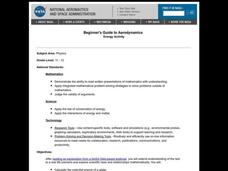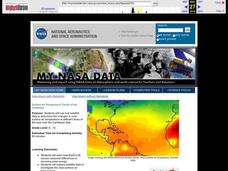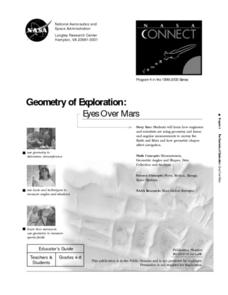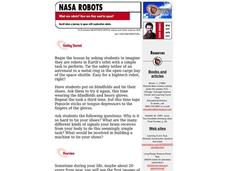Curated OER
Cross Section and Slope
Students draw cross sections of given contour maps. For this math lesson, students interpret the different symbols used in the map. They determine slope and steepness through direct measurement.
Curated OER
Particle Man and the Photon
Students simulate photon transmission, scattering and absorption. In this physics instructional activity, students explain why some objects appear bright while others appear dark. They define photon and radiation in their own words.
Curated OER
Preventing Hypothermia
Students identify the causes of hypothermia. For this biology lesson, students investigate the different types of heat transfer and heat loss. They discuss several practical measures to avoid hypothermia.
Curated OER
Seeing Interference Fringes with a Telescope
Students construct an interferometer using a simple telescope. In this physics instructional activity, students explain how light waves create the fringe patterns. They observe patterns made by different objects in the sky and compare them.
Curated OER
Wing Area
Young scholars demonstrate an understanding of the text by applying it to the calculations involving the area of a wing. They use an online textbook to help them calculate the area of the surface of wing planforms.
Curated OER
Energy Problem Set
Students calculate the potential energy of a glider, the kinetic energy of a moving glider and the change in velocity when potential energy changes to kinetic energy.
Curated OER
Airplane Parts Problem Set
Students identify the parts of an airplane and determine the part(s) of an airplane that cause a specfic action.
Curated OER
The Lift Equation
Learners use the FoilSim educational software program to complete an activity regarding lift. They solve a multivariable equation for each of the variables and apply the results to various problems in different situations.
Curated OER
How Does Altitude Relate To Density?
Students demonstrate an understanding of the properties of matter by applying them to density, pressure, and temperature. The educational software program, "Foilsim" is used in this inquiry.
Curated OER
Lift Relationships
Students use FoilSim (downloadable) to determine how lift is affected by varying parameters on the Airfoil simulation.
Curated OER
Actual Airflow vs. Ideal Airflow: Stalls
Students use 3-D modeling techniques to observe the characteristic signature of the stall condition apparent on an airfoil at high angles of attack. They use FoilSim to compare the above with ideal airflow.
Curated OER
Using Radiosonde Data From a Weather Balloon Launch
Student use radiosonde data from a weather balloon launch to distinguish the characteristics of the lower atmosphere. They learn the layers of the atmosphere. They graph real atmospheric data.
Curated OER
Where Is Saturn in the Solar System? Where Am I in the Solar System?
Students discover the planets and their location in the solar system. They complete a KWL chart on Saturn and discuss. They complete the lesson with a writing activity.
Curated OER
Earth to Saturn, Earth to Saturn!
Learners compare and contrast the characteristics of Earth and Saturn. They practice writing analogies using those characteristics. They complete a worksheet to end the instructional activity.
Curated OER
Comparison of Snow Cover on Different Continents
Students use the Live Access Server (LAS) to form maps and a numerical text file of snow cover for each continent on a particular date. They analyze the data for each map and corresponding text file to determine an estimate of snow cover...
Curated OER
Linkages Between Surface Temperature And Tropospheric Ozone
Students collect and interpret data to make predictions about the levels of ozone in the atmosphere. Using the internet to collect data students use their collected data to create a line graph for analysis. Students make mathematical...
Curated OER
Surface Air Temperature Trends of the Caribbean
Students investigate the seasonal changes to sea surface and near-surface air temperatures near the equator. They use actual satellite data to track and graph the differences in air and sea temperatures during different seasons in the...
Curated OER
Geometry of Exploration: Eyes Over Mars
Students research how engineers and scientists generate linear and angular measurements with geometry to survey the Earth and Mars. They assess how geometric shapes affect navigation. A surveyor comes to the classroom and explains how he...
Curated OER
Robots
Students play the parts of robots and their controllers. In this robot lesson plan, students learn about robots, and use verbal commands to simulate how a robot would command to it's controller.
Curated OER
Where Is Saturn in the Solar System? Where Am I in the Solar System?
Students engage in a solar system activity, In this activity, students will read aloud as a class about the solar system. The students will then listen to the teacher read a solar system book prior to filling out a worksheet about their...
Curated OER
Earth Turns? Prove It!
Students construct a pendulum using a washer and thin fishing line. In this earth science activity, students simulate Earth's rotation using the pendulum bob and swivel chair. They explain how this activity proves that the Earth is...
Curated OER
Why is There a Tidal Bulge Opposite the Moon?
Students simulate how the Moon causes ocean tides. In this earth science lesson, students calculate gravitational acceleration using a mathematical formula. They compare the force of attraction between the Earth, Moon and Sun system.
Curated OER
Geometry Problem Set I
Students prove angles congruent by use of vertical angles definition, subtraction postulate, and transitivity postulate.
Curated OER
Turbojet Thrust
Students, after reading the Web page Turbojet Thrust and completing the activity, explain how jet engines use air to produce thrust. The educational software ""FoilSim" is used in this lesson to help students calculate thrust.
Other popular searches
- Nasal Passages
- About Nasa
- Nasa Planets
- Nasa Robots
- Nasa Lesson Math
- Nasa Aircraft
- Nasa Materials
- History of Nasa
- Nasa Lesson Plans
- Nasa Web Based Textbook
- Nasa Aurora
- Contributions of Nasa

























